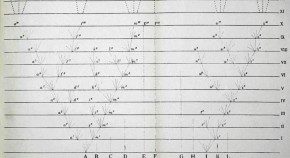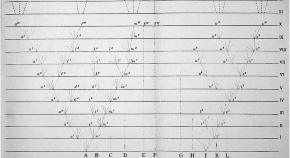
Collection
Darwin Collection
- Submission status
- Closed
JHB’s Darwin Collection By Marsha Richmond (Wayne State University, Detroit, MI, USA) and Karen Rader (Virginia Commonwealth University, Richmond, VA, USA). Since its founding in 1968, the Journal of the History of Biology has been a flagship outlet for Darwin studies. To date, JHB has published over 700 articles that either focus directly on Darwin or discuss how his work influenced biologists and biology. Early in the journal’s history, this scholarship drew on the new availability of Darwin’s archive at Cambridge University. Since 1985, marked by the publication of volume 1 of the Correspondence of Charles Darwin, studies of Darwin and Victorian science have been substantively enriched by the wealth of information included in letters to and from Darwin that were made available by the Darwin Correspondence Project (DCP). Founded in 1974 by Frederick H. Burkhardt, former president of the American Council of Learned Societies, the aim of the DCP was “locating and researching all known letters to and from Charles Darwin, [and] … publishing complete texts together with notes and appendices that make them comprehensible to the modern reader.” After 37 years, and countless hours of meticulous work performed by several generations of editors, this year witnesses the conclusion of the DCP, marked by the publication of volume 30 of the Correspondence. As Sam Schweber noted in his JHB review of the first two volumes, the Correspondence is important “not only for depicting Darwin’s intellectual development within the context of his whole life, but also for understanding the cultural, economic, intellectual, and social context in which these developments took place.” It is an understatement to say that the history of biology and Victorian science more generally have been revolutionized by this mammoth scholarly enterprise. JHB, with the support and encouragement of Springer/Nature, now marks this significant occasion by making available online a series of about one hundred selected classic as well as contemporary JHB articles on Darwin, published over a fifty year span. Moreover, framing these digital materials are three new reflective historiographic essays that appear both online and in JHB volume 55 (2). Janet Browne expansively surveys recent trends in Darwin historiography; Paul White contrasts the aims of early Victorian “life and letters” projects with new approaches to using Darwin’s correspondence to construct scientific biographies; and Bernie Lightman offers creative suggestions about how Darwin’s correspondence is an invaluable resource for pedagogy, introducing students to using primary sources in historical analysis and interpretation. These well complement the articles in the Darwin Collection. Our hope is that this collection of materials will better enable our readers – including historians of biology and biologists -- to review for themselves past assessments as well as present directions in Darwin scholarship. Such an enterprise, like the DCP itself, could reveal important changes in ideas about Darwin and his work, but also suggest productive new directions in the disciplines of the history of biology and the history of science.
Editors
-
Karen Rader
Marsha L. Richmond received a PhD in history of biology from Indiana University in 1986, studying under Fred Churchill. She was an Editor on the Darwin Correspondence Project, Cambridge, England, 1987-1993. She joined the faculty of Wayne State University in Fall 1994, first in the Interdisciplinary Studies Program and, since 2008, the Department of History, retiring as Emerita Professor in May 2022. With Ida Stamhuis (Vreje University, Amsterdam), she is completing an international comparison of women in genetics, 1900-1940, and a scientific biography of Theo Colborn and endocrine-disrupting chemicals in the environment.
-
Marsha Richmond
Karen Rader studies the intellectual, cultural, and social history of the modern life sciences in the United States. Her most recent book, co-authored with Victoria Cain, is Life on Display: Revolutionizing U.S. Museums of Science and Natural History in the Twentieth Century. She was Vice President of the History of Science Society (2020-2021) and is Co-Editor-in-Chief of the Journal of the History of Biology.
Articles (95 in this collection)
-

-
Eclipsing the Eclipse?: A Neo-Darwinian Historiography Revisited
Authors
- Max Meulendijks
- Content type: Original Research
- Published: 09 September 2021
- Pages: 403 - 443
-
Making a French Connection: Darwin, Brown-Séquard and the Epilepsy Studies
Authors
- Patrick M. Walsh
- Content type: Original Research
- Published: 07 September 2021
- Pages: 375 - 401
-
A Critique of Darwin’s The Descent of Man by a Muslim Scholar in 1912: Muḥammad-Riḍā Iṣfahānī's Examination of the Anatomical and Embryological Similarities Between Human and Other Animals
Authors
- Amir-Mohammad Gamini
- Content type: Original Research
- Published: 01 July 2021
- Pages: 485 - 511

-
Trees, Coral, and Seaweed: An Interpretation of Sketches Found in Darwin’s Papers
Authors
- Kees van Putten
- Content type: Original Research
- Open Access
- Published: 04 February 2020
- Pages: 5 - 44

-
An Origin of Citations: Darwin’s Collaborators and Their Contributions to the Origin of Species
Authors
- Pedro de Lima Navarro
- Cristina de Amorim Machado
- Content type: Original Research
- Published: 21 January 2020
- Pages: 45 - 79

-
A Reappraisal of Charles Darwin’s Engagement with the Work of William Sharp Macleay
Authors
- Aaron Novick
- Content type: Original Paper
- Published: 10 September 2018
- Pages: 245 - 270
-
Loren Graham, Lysenko’s Ghost: Epigenetics and Russia (Cambridge, MA: Harvard University Press, 2016), 224 pp., illus., bibl., $24.95 Hardback, ISBN 9780674089051
Authors
- Andy Bruno
- Content type: Book Review
- Published: 06 September 2018
- Pages: 883 - 885
-
Charles Darwin, Richard Owen, and Natural Selection: A Question of Priority
Authors
- Curtis N. Johnson
- Content type: OriginalPaper
- Published: 03 May 2018
- Pages: 45 - 85
-
How Fast Does Darwin’s Elephant Population Grow?
Authors
- János Podani
- Ádám Kun
- András Szilágyi
- Content type: OriginalPaper
- Published: 19 July 2017
- Pages: 259 - 281
-
Darwin’s “Mr. Arthrobalanus”: Sexual Differentiation, Evolutionary Destiny and the Expert Eye of the Beholder
Authors
- Roderick D. Buchanan
- Content type: OriginalPaper
- Published: 20 April 2016
- Pages: 315 - 355
-
Paleontology and Darwin’s Theory of Evolution: The Subversive Role of Statistics at the End of the 19th Century
Authors
- Marco Tamborini
- Content type: OriginalPaper
- Published: 11 March 2015
- Pages: 575 - 612
-
Darwin, Malthus, Süssmilch, and Euler: The Ultimate Origin of the Motivation for the Theory of Natural Selection
Authors
- Dominic Klyve
- Content type: OriginalPaper
- Published: 15 August 2013
- Pages: 189 - 212
-
Darwin and His Pigeons. The Analogy Between Artificial and Natural Selection Revisited
Authors
- Bert Theunissen
- Content type: OriginalPaper
- Published: 29 October 2011
- Pages: 179 - 212
-
Darwin’s Sublime: The Contest Between Reason and Imagination in On the Origin of Species
Authors
- Benjamin Sylvester Bradley
- Content type: OriginalPaper
- Published: 13 November 2009
- Pages: 205 - 232
-
Rethinking the Synthesis Period in Evolutionary Studies
Authors
- Joe Cain
- Content type: OriginalPaper
- Published: 02 October 2009
- Pages: 621 - 648
-
Charles Darwin’s Beagle Voyage, Fossil Vertebrate Succession, and “The Gradual Birth & Death of Species”
Authors
- Paul D. Brinkman
- Content type: OriginalPaper
- Published: 16 June 2009
- Pages: 363 - 399
-
Capitalist Contexts for Darwinian Theory: Land, Finance, Industry and Empire
Authors
- M. J. S. Hodge
- Content type: OriginalPaper
- Published: 28 May 2009
- Pages: 399 - 416
-
Darwin and Inheritance: The Influence of Prosper Lucas
Authors
- Ricardo Noguera-Solano
- Rosaura Ruiz-Gutiérrez
- Content type: OriginalPaper
- Published: 23 January 2009
- Pages: 685 - 714
-
Sources of Wilhelm Johannsen’s Genotype Theory
Authors
- Nils Roll-Hansen
- Content type: OriginalPaper
- Published: 11 November 2008
- Pages: 457 - 493
-
Emancipation Through Interaction – How Eugenics and Statistics Converged and Diverged
Authors
- Francisco Louçã
- Content type: OriginalPaper
- Published: 04 November 2008
- Pages: 649 - 684
-
Edward Hitchcock’s Pre-Darwinian (1840) “Tree of Life”
Authors
- J. David Archibald
- Content type: OriginalPaper
- Published: 03 September 2008
- Pages: 561 - 592
-
The Gentleman and the Rogue: The Collaboration Between Charles Darwin and Carl Vogt
Authors
- Martin Amrein
- Kärin Nickelsen
- Content type: OriginalPaper
- Published: 11 October 2007
- Pages: 237 - 266
-
Wallace, Darwin, and the Practice of Natural History
Authors
- Melinda B. Fagan
- Content type: OriginalPaper
- Published: 24 April 2007
- Pages: 601 - 635
-
The Preface to Darwin’s Origin of Species: The Curious History of the “Historical Sketch” *
Authors
- Curtis N. Johnson
- Content type: OriginalPaper
- Published: 18 January 2007
- Pages: 529 - 556
-
Separated at Birth: The Interlinked Origins of Darwin’s Unconscious Selection Concept and the Application of Sexual Selection to Race
Authors
- Stephen G. Alter
- Content type: OriginalPaper
- Published: 13 October 2006
- Pages: 231 - 258
-
Against “Revolution” and “Evolution”
Authors
- Jonathan Hodge
- Content type: OriginalPaper
- Published: 01 March 2005
- Pages: 101 - 121
-
“It Ain’t Over ‘til it’s Over”: Rethinking the Darwinian Revolution
Authors
- Vassiliki Betty Smocovitis
- Content type: OriginalPaper
- Published: 01 March 2005
- Pages: 33 - 49
-
The Darwinian Revolution, as seen in 1979 and as seen Twenty-Five Years Later in 2004
Authors
- Michael Ruse
- Content type: OriginalPaper
- Published: 01 March 2005
- Pages: 3 - 17
-
The Darwinian revolution as viewed by a philosophical biologist
Authors
- Michael T. Ghiselin
- Content type: OriginalPaper
- Published: 01 March 2005
- Pages: 123 - 136
-
The Darwinian Revolution Revisited
Authors
- Sandra Herbert
- Content type: OriginalPaper
- Published: 01 March 2005
- Pages: 51 - 66
-
Darwin’s Methodological Evolution
Authors
- James G. Lennox
- Content type: OriginalPaper
- Published: 01 March 2005
- Pages: 85 - 99
-
Revisiting the eclipse of Darwinism
Authors
- Peter J. Bowler
- Content type: OriginalPaper
- Published: 01 March 2005
- Pages: 19 - 32
-
Deconstructing Darwin: Evolutionary theory in context
Authors
- David L. Hull
- Content type: OriginalPaper
- Published: 01 March 2005
- Pages: 137 - 152
-
George John Romanes's defense of darwinism: The correspondence of Charles Darwin and his chief disciple
Authors
- Joel S. Schwartz
- Content type: OriginalPaper
- Pages: 281 - 316
-
On the road to the Origin with Darwin, Hooker, and Gray
Authors
- Duncan M. Porter
- Content type: OriginalPaper
- Pages: 1 - 38
-
-
Charles Darwin's health problems: The allergy hypothesis
Authors
- Fabienne Smith
- Content type: OriginalPaper
- Pages: 285 - 306
-
Darwin and domestication: Studies on inheritance
Authors
- Mary M. Bartley
- Content type: OriginalPaper
- Pages: 307 - 333
-
Darwin on man in theOrigin of species: Further factors considered
Authors
- Nelio Marco Vincenzo Bizzo
- Content type: OriginalPaper
- Pages: 137 - 147
-
Darwin on man in the Origin of Species: An addendum to the Bajema-Bowler debate
Authors
- Kathy J. Cooke
- Content type: OriginalPaper
- Pages: 517 - 521
-
-
Darwin, Wallace, and Huxley, and Vestiges of the Natural History of Creation
Authors
- Joel S. Schwartz
- Content type: OriginalPaper
- Pages: 127 - 153
-
Darwin on man in the Origin of Species: A reply to Carl Bajema
Authors
- Peter J. Bowler
- Content type: OriginalPaper
- Pages: 497 - 500
-
Darwin and political economy: The connection reconsidered
Authors
- Scott Gordon
- Content type: OriginalPaper
- Pages: 437 - 459
-
John Herschel and Charles Darwin: A study in parallel lives
Authors
- S. S. Schweber
- Content type: OriginalPaper
- Pages: 1 - 71
-
Charles Darwin on man in the first edition of the Origin of Species
Authors
- Carl J. Bajema
- Content type: OriginalPaper
- Pages: 403 - 410
-
Essay review: The Correspondence of the young Darwin
Authors
- Silvan S. Schweber
- Content type: ReviewPaper
- Pages: 501 - 519
-
Darwin and divergence: The Wallace connection
Authors
- Barbara G. Beddall
- Content type: OriginalPaper
- Pages: 1 - 68
-
God's magnificent law: The bad influence of theistic metaphysics on Darwin's estimation of natural selection
Authors
- John F. Cornell
- Content type: OriginalPaper
- Pages: 381 - 412



